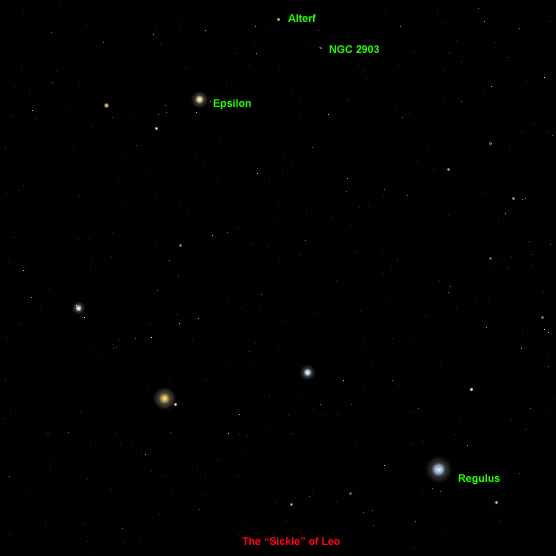About NGC 2903: This beautiful barred spiral galaxy was somehow missed by Charles Messier when he compiled the Messier Catalog. William Herschel discovered it on November 16th, 1784 in his systematic survey of the sky. Close inspection of the image above reveals a number of bright areas in the galaxy's core where star formation is going on at a rapid rate. A view of the core of the galaxy by the Hubble Space Telescope can be found here. The two brightest background galaxies are seen along the bottom of the image. The left very diffuse galaxy is PGC 27115 and the tiny barred spiral on the right is PCG 1648681. Both are around 16th magnitude. There are quite a few more galaxies that are visible in the background of the image that are smaller and fainter. The smallest ones just look like fuzzy stars.
Finding NGC 2903: Because of it's proximity to several bright stars, this galaxy is relatively easy to find in small telescopes, though like many deep sky objects it looks like a very small misty patch of light. Still, just seeing the great star system, knowing that the photons hitting your retina are 30,000,000 years old, is fun. Start by finding the constellation of Leo. You can refer to the constellation chart for this month on the Natural Calendar for this. Remember that by clicking on this chart or on either of the charts below you will get a printable black-stars-on-white-background version of the chart for use outside. It's best to use a red flashlight with the charts to preserve your night vision. Next, use the Wide Field Finder Chart below to locate the 4th magnitude star Alterf. It is a faint naked eye star just off the end of the "Sickle" of Leo near Epsilon Leonis. Find Alterf in your binocular or finder scope. Now use the Binocular finder chart at the bottom of this page to locate two 7th magnitude stars about 1 degree away from Alterf. Use the distance and direction of Epsilon to estimate their position. NGC 2903 makes a nifty little right triangle with these two stars. The galaxy is quite a bit fainter than the stars, so you may need a clear moonless night to see it. Also try using averted vision; look to one side of the galaxy and see if it pops into your peripheral vision. On a dark night the galaxy is not hard to see in my Televue 85mm refractor. It's said to be visible in binoculars in very dark skies. In our 20" Newtonian telescope, the inner spiral arm pattern is discernable.
|
||||||||||||||||||||||


